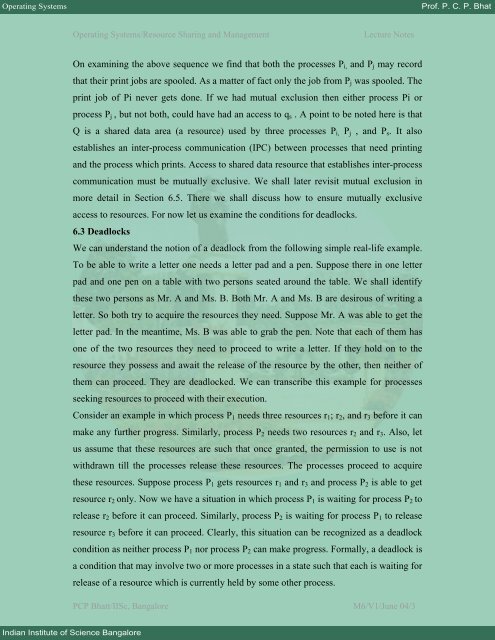Module 6: Resource Sharing and Management - E-Courses
Module 6: Resource Sharing and Management - E-Courses
Module 6: Resource Sharing and Management - E-Courses
Create successful ePaper yourself
Turn your PDF publications into a flip-book with our unique Google optimized e-Paper software.
Operating Systems Prof. P. C. P. Bhat<br />
Indian Institute of Science Bangalore<br />
Operating Systems/<strong>Resource</strong> <strong>Sharing</strong> <strong>and</strong> <strong>Management</strong> Lecture Notes<br />
On examining the above sequence we find that both the processes Pi, <strong>and</strong> Pj may record<br />
that their print jobs are spooled. As a matter of fact only the job from Pj was spooled. The<br />
print job of Pi never gets done. If we had mutual exclusion then either process Pi or<br />
process Pj , but not both, could have had an access to qs . A point to be noted here is that<br />
Q is a shared data area (a resource) used by three processes Pi, Pj , <strong>and</strong> Ps. It also<br />
establishes an inter-process communication (IPC) between processes that need printing<br />
<strong>and</strong> the process which prints. Access to shared data resource that establishes inter-process<br />
communication must be mutually exclusive. We shall later revisit mutual exclusion in<br />
more detail in Section 6.5. There we shall discuss how to ensure mutually exclusive<br />
access to resources. For now let us examine the conditions for deadlocks.<br />
6.3 Deadlocks<br />
We can underst<strong>and</strong> the notion of a deadlock from the following simple real-life example.<br />
To be able to write a letter one needs a letter pad <strong>and</strong> a pen. Suppose there in one letter<br />
pad <strong>and</strong> one pen on a table with two persons seated around the table. We shall identify<br />
these two persons as Mr. A <strong>and</strong> Ms. B. Both Mr. A <strong>and</strong> Ms. B are desirous of writing a<br />
letter. So both try to acquire the resources they need. Suppose Mr. A was able to get the<br />
letter pad. In the meantime, Ms. B was able to grab the pen. Note that each of them has<br />
one of the two resources they need to proceed to write a letter. If they hold on to the<br />
resource they possess <strong>and</strong> await the release of the resource by the other, then neither of<br />
them can proceed. They are deadlocked. We can transcribe this example for processes<br />
seeking resources to proceed with their execution.<br />
Consider an example in which process P1 needs three resources r1; r2, <strong>and</strong> r3 before it can<br />
make any further progress. Similarly, process P2 needs two resources r2 <strong>and</strong> r3. Also, let<br />
us assume that these resources are such that once granted, the permission to use is not<br />
withdrawn till the processes release these resources. The processes proceed to acquire<br />
these resources. Suppose process P1 gets resources r1 <strong>and</strong> r3 <strong>and</strong> process P2 is able to get<br />
resource r2 only. Now we have a situation in which process P1 is waiting for process P2 to<br />
release r2 before it can proceed. Similarly, process P2 is waiting for process P1 to release<br />
resource r3 before it can proceed. Clearly, this situation can be recognized as a deadlock<br />
condition as neither process P1 nor process P2 can make progress. Formally, a deadlock is<br />
a condition that may involve two or more processes in a state such that each is waiting for<br />
release of a resource which is currently held by some other process.<br />
PCP Bhatt/IISc, Bangalore M6/V1/June 04/3

















